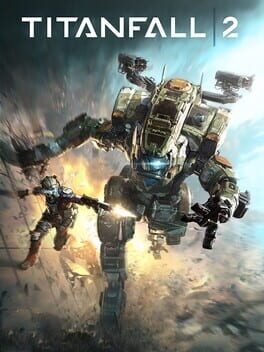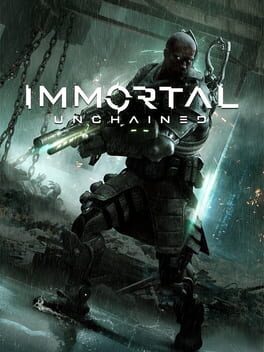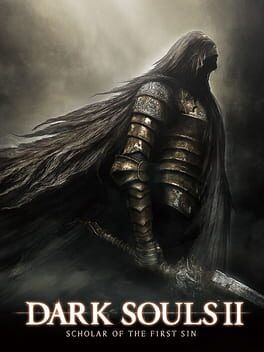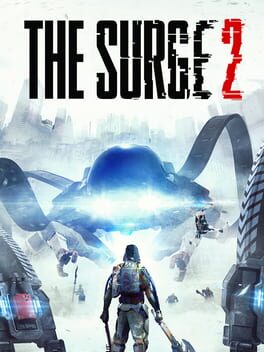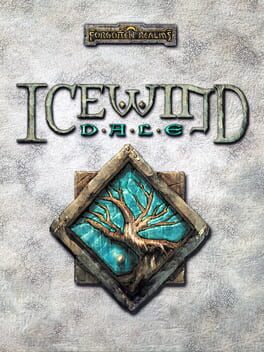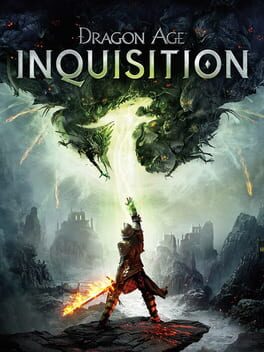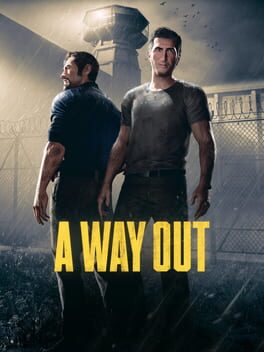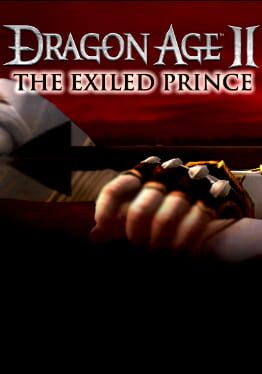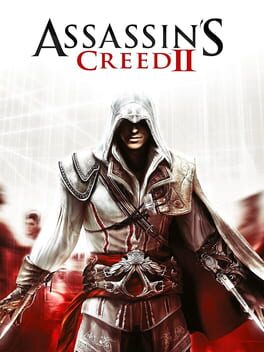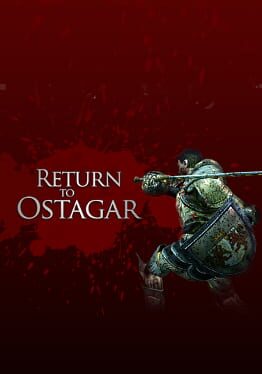squid0812
BACKER
2016
Conceivably the tightest and most satisfying first-person action platformer ever made. Unfortunately, it's also saddled with the same sort of slick yet forgettable narrative that the Call of Duty franchise has been putting out for years.
Movement in this game is such a sheer joy. The wall-running, double jump, and slide all combine to form a genuinely thrilling mixture. All of the best elements of the first game - the speed, the finesse, the responsiveness - are present here, and this time around the developers at Respawn had the good sense to actually design spaces where these features can really shine (as opposed to the first game, which largely consisted of a series of anonymous maps that bore little difference to any number of generic FPS settings). In terms of pure wireframe, the level design here is surprisingly quite good - the famous time travel level, for instance, is indeed a standout. But the real star of the show is the automated assembly line that churns out prefab suburbs, a setting that's simultaneously satisfying to navigate and surreal to experience.
Sadly, I didn't care a lick about any of the characters or the story. Granted, it's nothing embarrassing - the voice acting is competent and the pacing is svelte enough that the campaign doesn't overstay its welcome. But it's very much generic AAA style-over-substance. The dialogue is quippy without being particularly funny. Showy poses take the place of meaningful themes. And they clearly didn't even try to come up with a compelling antagonist - the villainous mercenaries here are all over-the-top mustache-twirlers straight out of central casting.
It's all a bit upsetting (if unsurprising), because a genuinely engaging narrative and a few well-drawn characters likely would have elevated this into masterpiece territory for me. As is, it's an extremely fun game in the hands that didn't leave much of a mark on my heart or my mind.
Movement in this game is such a sheer joy. The wall-running, double jump, and slide all combine to form a genuinely thrilling mixture. All of the best elements of the first game - the speed, the finesse, the responsiveness - are present here, and this time around the developers at Respawn had the good sense to actually design spaces where these features can really shine (as opposed to the first game, which largely consisted of a series of anonymous maps that bore little difference to any number of generic FPS settings). In terms of pure wireframe, the level design here is surprisingly quite good - the famous time travel level, for instance, is indeed a standout. But the real star of the show is the automated assembly line that churns out prefab suburbs, a setting that's simultaneously satisfying to navigate and surreal to experience.
Sadly, I didn't care a lick about any of the characters or the story. Granted, it's nothing embarrassing - the voice acting is competent and the pacing is svelte enough that the campaign doesn't overstay its welcome. But it's very much generic AAA style-over-substance. The dialogue is quippy without being particularly funny. Showy poses take the place of meaningful themes. And they clearly didn't even try to come up with a compelling antagonist - the villainous mercenaries here are all over-the-top mustache-twirlers straight out of central casting.
It's all a bit upsetting (if unsurprising), because a genuinely engaging narrative and a few well-drawn characters likely would have elevated this into masterpiece territory for me. As is, it's an extremely fun game in the hands that didn't leave much of a mark on my heart or my mind.
2012
Neon, synths, and ultra-violence - that’s the game. And it works much better than it has any right to, largely due to an impressive commitment to capturing the essence (rather than the specific details) of a particular time and place (Miami, 1989), as well as frenetic and freewheeling gameplay that meshes beautifully with the synthwave soundtrack.
Take a look at a still photo of Hotline Miami gameplay, and it may strike one as crass, even amateurish. It’s only in the act of play that this aesthetic comes to life. The immensely satisfying gunplay, the way the doors spring open wildly as the player character bursts into a room, the way the screen subtly shifts and sways as you navigate the level - it’s details like these that make the play seem so ineffably rhythmic. The controls are bit odd and the difficulty will likely take some getting used to - but ultimately the gameplay here doesn’t really feel like anything else I’ve played. And that’s extremely valuable.
The story here is a surreal look at the PC’s psyche being slowly destroyed by the consequences of meaningless violence (one of the subtle and brilliant ways the game sells this is by abruptly cutting off the music and forcing you to walk back through the path of devastation you’ve wrought at end of each level). The story works best in the early and middle sections when everything is mysterious and suggestive. The final act is more or less a dud - the game is missing a genuine climax - but the flavor and atmosphere had me engaged till the very end.
Narrative misgivings aside, this is a unique game that shouldn’t be missed (assuming one isn’t queasy about violence).
Take a look at a still photo of Hotline Miami gameplay, and it may strike one as crass, even amateurish. It’s only in the act of play that this aesthetic comes to life. The immensely satisfying gunplay, the way the doors spring open wildly as the player character bursts into a room, the way the screen subtly shifts and sways as you navigate the level - it’s details like these that make the play seem so ineffably rhythmic. The controls are bit odd and the difficulty will likely take some getting used to - but ultimately the gameplay here doesn’t really feel like anything else I’ve played. And that’s extremely valuable.
The story here is a surreal look at the PC’s psyche being slowly destroyed by the consequences of meaningless violence (one of the subtle and brilliant ways the game sells this is by abruptly cutting off the music and forcing you to walk back through the path of devastation you’ve wrought at end of each level). The story works best in the early and middle sections when everything is mysterious and suggestive. The final act is more or less a dud - the game is missing a genuine climax - but the flavor and atmosphere had me engaged till the very end.
Narrative misgivings aside, this is a unique game that shouldn’t be missed (assuming one isn’t queasy about violence).
2018
Narratively and tonally, this is a straight ripoff of Dark Souls, but I nevertheless appreciated the ideas the devs implemented here to transpose traditional Souls mechanics onto a third person shooter. For substantial portions of the game, it really works - the dodging and shooting feel just as wonderfully methodical and deliberate as the melee battles of the early Souls titles. That may seem like hyperbole, but I’d recommend trying it out - I really did walk away from this thinking about shooters and their viability in the Souls genre in a much more flattering light, which says a lot about the how the devs landed on something ineffable with the combat mechanics.
Beyond the combat, there’s unfortunately little to recommend here. The game looks pretty bad - the character models seem weirdly misshapen, the enemy and boss designs are repetitive, and the environments largely break down into monochrome hallways with few distinguishing environmental features. The first half of the game is well-balanced and appropriately challenging, but the second half is an infuriating slog with an over-abundance of copy-and-paste enemy layouts.
As I mentioned at the top, the tone and story structure of this game are so similar to Dark Souls that the devs at From Software should really consider suing. The one unique narrative element is the ending, an attempt at a meta twist that feels largely unearned, especially given the vague nature of the game’s lore. The more Soulslikes I play, the more I become convinced that attempting to emulate the elliptical storytelling of the original Souls games is a fool’s errand. There are very few games that have managed to capture that potent mixture of melancholy atmosphere and tantalizing lore hints, and Immortal: Unchained is definitely not one of them.
Still, there is potential here. I will be intrigued to see what these devs do next, particularly if they cast off their slavish devotion to imitating the best work of other studios.
Beyond the combat, there’s unfortunately little to recommend here. The game looks pretty bad - the character models seem weirdly misshapen, the enemy and boss designs are repetitive, and the environments largely break down into monochrome hallways with few distinguishing environmental features. The first half of the game is well-balanced and appropriately challenging, but the second half is an infuriating slog with an over-abundance of copy-and-paste enemy layouts.
As I mentioned at the top, the tone and story structure of this game are so similar to Dark Souls that the devs at From Software should really consider suing. The one unique narrative element is the ending, an attempt at a meta twist that feels largely unearned, especially given the vague nature of the game’s lore. The more Soulslikes I play, the more I become convinced that attempting to emulate the elliptical storytelling of the original Souls games is a fool’s errand. There are very few games that have managed to capture that potent mixture of melancholy atmosphere and tantalizing lore hints, and Immortal: Unchained is definitely not one of them.
Still, there is potential here. I will be intrigued to see what these devs do next, particularly if they cast off their slavish devotion to imitating the best work of other studios.
A game that gets far more hatred than it actually deserves, Dark Souls II's greatest sin for many people is that it isn't Dark Souls 1. Nevertheless, it is a fun game, despite some obvious flaws. As in all of the Souls games, there are plenty of ineffable enemy and environmental designs - areas like Drangleic Castle and the Shrine of Amana impress with their atmosphere of gloom and foreboding, while some other levels stand out simply for being extraordinarily beautiful (Heide's Tower of Flame, the Dragon Aerie, etc.) Character customization is deeper and more varied here as well, with the option to dual wield being an excellent addition. Not a popular opinion I know, but I prefer the more diverse combat possibilities of this game to the slightly more restrictive choices offered by the original.
That being said, some of the criticisms leveled at this game are definitely legitimate. Most significantly, the world and level design here suffer dramatically in comparison to the original. No matter how good-looking or atmospheric some of the levels are, it's undeniable that they don't fit together in a way that makes any sense. Too many of the levels are simply straightforward hallways as well - don't play this expecting the dense level design of Dark Souls III or Bloodborne. The story, while hinting at some potentially resonant themes about memory and the loss of one's identity, is an opaque mess (Aldia, a Mephistopheles-like figure, is added to the Scholar of the First Sin edition basically to periodically help explain the plot.) While some of the bosses (Pursuer, Lost Sinner, Velstadt, etc.) are cool, there are a number of filler bosses thrown in, which inevitably detracts from some of the excitement when you unexpectedly wander into a boss arena.
Still, an enjoyable game that shouldn't be neglected merely because it's not a generation-altering masterpiece like it's predecessor.
That being said, some of the criticisms leveled at this game are definitely legitimate. Most significantly, the world and level design here suffer dramatically in comparison to the original. No matter how good-looking or atmospheric some of the levels are, it's undeniable that they don't fit together in a way that makes any sense. Too many of the levels are simply straightforward hallways as well - don't play this expecting the dense level design of Dark Souls III or Bloodborne. The story, while hinting at some potentially resonant themes about memory and the loss of one's identity, is an opaque mess (Aldia, a Mephistopheles-like figure, is added to the Scholar of the First Sin edition basically to periodically help explain the plot.) While some of the bosses (Pursuer, Lost Sinner, Velstadt, etc.) are cool, there are a number of filler bosses thrown in, which inevitably detracts from some of the excitement when you unexpectedly wander into a boss arena.
Still, an enjoyable game that shouldn't be neglected merely because it's not a generation-altering masterpiece like it's predecessor.
2019
A significant improvement on the first game. The devs at Deck13 seem to have finally learned their lesson about varying up their environments so the player doesn’t get bored or lost (the fatal flaw of both Lords of the Fallen and the first Surge). It’s not like the urban landscape is particularly riveting as a set piece, but at very least the environments are clearly delineated and differentiated from one another - I always had a good sense of where I was and where I needed to go next. Not exactly glowing praise, but it’s a step forward at least.
The mechanical changes from the original game also tend to be in this game’s favor. In the first game, it was easy to spam dismemberments and end up with a lot of unneeded vendor trash, but here slashing off limbs is tied to battery power, the same resource that you use to heal. So, the game creates an interesting choice - dismember the enemy for parts or hold on to the battery power for a potential future heal. Adding onto to the complexity of this system is the fact that you refill your battery power by attacking. This encourages aggression in a way that reminded me a little bit of Bloodborne’s rally system. Indeed, considering that this is also a much faster game than its predecessor, the shift from the stodginess of Dark Souls to the nimble ballet of Bloodborne is a rather apt analogy for the relationship between the original Surge and its sequel.
Except that Dark Souls and Bloodborne are packed to the gills with weird and evocative concepts and ineffable set pieces, while The Surge…well, it’s sci-fi gobbledygook in the worst way. Genuinely, I admire how the devs at Deck13 have clearly improved since they got into the Soulslike business with Lords of the Fallen. But the one thing that has never changed, whether in Lords of the Fallen, The Surge 1, or here, is that their narratives are so bereft of inspiration, their writing so bland, that my eyes glaze over as soon as the characters open their mouths. I really hope my experience changes with their future games, but I’m not hopeful. The narrative here centers around trying to find a little girl with nanite powers (yep, not joking) before a petulant, snot-nosed cult leader named Eli can steal the aforementioned powers for himself. Transhumanism, worship of technology, corporate malfeasance - all of your typical sci-fi cliches are incorporated here, if only half-heartedly.
I didn’t care one iota for the story, as you might have guessed, but I won’t deny that the actual act of playing this game is pretty damn fun. So, it’s empty calories. But what would life be without an indulgent little snack every once in awhile?
The mechanical changes from the original game also tend to be in this game’s favor. In the first game, it was easy to spam dismemberments and end up with a lot of unneeded vendor trash, but here slashing off limbs is tied to battery power, the same resource that you use to heal. So, the game creates an interesting choice - dismember the enemy for parts or hold on to the battery power for a potential future heal. Adding onto to the complexity of this system is the fact that you refill your battery power by attacking. This encourages aggression in a way that reminded me a little bit of Bloodborne’s rally system. Indeed, considering that this is also a much faster game than its predecessor, the shift from the stodginess of Dark Souls to the nimble ballet of Bloodborne is a rather apt analogy for the relationship between the original Surge and its sequel.
Except that Dark Souls and Bloodborne are packed to the gills with weird and evocative concepts and ineffable set pieces, while The Surge…well, it’s sci-fi gobbledygook in the worst way. Genuinely, I admire how the devs at Deck13 have clearly improved since they got into the Soulslike business with Lords of the Fallen. But the one thing that has never changed, whether in Lords of the Fallen, The Surge 1, or here, is that their narratives are so bereft of inspiration, their writing so bland, that my eyes glaze over as soon as the characters open their mouths. I really hope my experience changes with their future games, but I’m not hopeful. The narrative here centers around trying to find a little girl with nanite powers (yep, not joking) before a petulant, snot-nosed cult leader named Eli can steal the aforementioned powers for himself. Transhumanism, worship of technology, corporate malfeasance - all of your typical sci-fi cliches are incorporated here, if only half-heartedly.
I didn’t care one iota for the story, as you might have guessed, but I won’t deny that the actual act of playing this game is pretty damn fun. So, it’s empty calories. But what would life be without an indulgent little snack every once in awhile?
2000
A series of dungeon crawls built for those who live for the challenges presented by 2nd Edition D and D combat, don't expect a story-driven RPG ala Baldur's Gate. The story here is a bare-minimum excuse for your customized party of six to fight a LOT of gank squads - if you think some of the mobs in Baldur's Gate are excessive, you will be flat-out knocked on your ass by the veritable armies of scrubs you will have to scrape through in IWD (especially true in Trials of the Luremaster, arguably the most balls-hard section of an already difficult game). There are actually a number of good-looking and even atmospheric dungeons scattered throughout this 40+ (50+ with the expansion) hour game, but most of these feel divorced from any context due to the threadbare motivations offered by the story. The bosses (Yxunomei, Behilfet, Icarasaracht from the Heart of Winter expansion) are also challenging and tense, but the constant attrition from trash mobs made me ultimately question whether a few cool positives were worth it in the end. One good option allowed by the enhanced edition is to set up a separate playthrough of the Heart of Winter expansion, detached from the main game. Since it is shorter and slightly more story-focused than the main game, it might actually serve as a solid gauge of interest for those on the fence about playing this.
For me, this is the lesser of the two story expansions for Dragon Age II (I’m not counting The Exiled Prince DLC). A big part of how much one enjoys this is going to come down to how they feel about Felicia Day’s performance as Tallis. Tallis is a bit too cloying and aloof for my liking - she’s full of smarmy wisecracks and showy acrobatics, but lacks the elements that would make her feel like a multidimensional character rather than a collection of haughty poses. The game also rather transparently expects your character to pursue a fling with her, so if you don’t, there are a few moments of jokey flirtation that end up feeling weirdly dissonant.
I will give the developers credit for using the DLC as an opportunity to experiment with unconventional gameplay mechanics. I never thought I’d see stealth sequences in a Dragon Age game. Unsurprisingly, it doesn’t really work, but I appreciate the effort to think outside the box. More successful is the party sequence, which feels a bit like a miniaturized dry run for the verbal tête-à-têtes of the ‘Wicked Eyes and Wicked Hearts’ mission from Dragon Age: Inquisition (easily the best part of that game).
Everything else here - from the dungeon crawling to the bosses - is simply more Dragon Age II, with all the positives and negatives that go along with it. If that’s what you’re looking for, then this expansion delivers the goods.
I will give the developers credit for using the DLC as an opportunity to experiment with unconventional gameplay mechanics. I never thought I’d see stealth sequences in a Dragon Age game. Unsurprisingly, it doesn’t really work, but I appreciate the effort to think outside the box. More successful is the party sequence, which feels a bit like a miniaturized dry run for the verbal tête-à-têtes of the ‘Wicked Eyes and Wicked Hearts’ mission from Dragon Age: Inquisition (easily the best part of that game).
Everything else here - from the dungeon crawling to the bosses - is simply more Dragon Age II, with all the positives and negatives that go along with it. If that’s what you’re looking for, then this expansion delivers the goods.
I should say from the outset that I should have been the easiest mark in the world for a game like this. I am complete sucker for just these kind of epic fantasy stories. With that being said, it’s actually hard for me to think of a time when I’ve been this disappointed by a game. So much about this is first-rate - the beautifully rendered environments, the deep world building, the lively and varied cast of companions. And yet BioWare, in the misguided pursuit of producing their own version of Skyrim, saddled themselves with a boring, MMO-inspired questing structure and overly complex loot grind that very nearly sinks the game. There are entire maps here that are nothing but vast arenas for checking off lists: closing rifts (here’s a tip: the fiftieth time you do this won’t feel any different from the first), finding shards (seriously, what the hell are these? And why do I care?), and picking up Object X for anonymous NPC Y. This is no exaggeration: there are at least 4-5 areas in this game where you do nothing else beside this garbage. They have zero to do with the main storyline. If you are picking this up now, have mercy on yourself and use a guide to skip the mindless drivel. Then again, you might not need it - if you find yourself bored stiff while collecting 10 bunches of elfroot, know that you have strayed from the path.
Which isn’t to say that everything else about the game is perfect, but at least playing through the main storyline allows you to make real choices and interact with your companions and the world in a unique way. Many of the companion quests, in the typical BioWare style, are also meaningful. The best of them (Dorian’s, Iron Bull’s, etc.), allow you to make choices that can completely transform your relationship with the character in both subtle and obvious ways. The real problem with the story, as occurs all too frequently these days, is that the actual ending was held back for DLC bait. Without Trespasser, the aforementioned DLC, the ending feels abrupt and the main villain (a pull from the Dragon Age 2 DLC who was a lot more interesting in that game) is severely underdeveloped. But then again, you might be too busy hunting down rams or collecting rashvine to care.
Which isn’t to say that everything else about the game is perfect, but at least playing through the main storyline allows you to make real choices and interact with your companions and the world in a unique way. Many of the companion quests, in the typical BioWare style, are also meaningful. The best of them (Dorian’s, Iron Bull’s, etc.), allow you to make choices that can completely transform your relationship with the character in both subtle and obvious ways. The real problem with the story, as occurs all too frequently these days, is that the actual ending was held back for DLC bait. Without Trespasser, the aforementioned DLC, the ending feels abrupt and the main villain (a pull from the Dragon Age 2 DLC who was a lot more interesting in that game) is severely underdeveloped. But then again, you might be too busy hunting down rams or collecting rashvine to care.
2018
A difficult game to critique, for two reasons. Firstly, so much of its appeal is due to its reliance on couch co-op (this is playable as online co-op but it seems to me like that would eliminate a lot of the fun). Secondly, I have no clue if the people who made this game were in on the joke - this is low-key one of the funniest games I’ve ever played, but the humor seems to be at least partly unintentional.
The story here is a pile of cliches derived from American crime movies of the past fifty years. Again, I’m not sure if the developers wanted us to take this plot seriously, but my wife and I were laughing constantly at how the game continuously churns out bad, weirdly off-kilter imitations of scenes that you’ve seen in a hundred different movies - and all with a straight face. A large part of the goofiness is derived from the voice acting, which ranges from eerily emotionless (Vincent) to sounding like an alien in disguise visiting Earth for the first time (Leo). So many of the line readings here sound strangely divorced from their context. In a way, it helps - every time we got bored with the story, one of the characters would say something ridiculous and get us laughing again. But, again, expecting much beyond a few so-bad-it’s-good chuckles from the story is a fool’s errand.
Gameplay-wise, the co-op elements are occasionally intriguing - there are a few sequences, like the jailbreak, that force the players to work together in an interesting way. As the game goes on, the gameplay gets a lot less engaging, though. There are a few sequences in which the players are let loose to explore individually - but this is not an really an exploration-based game, so I typically found myself bored stiff during these parts. There a few shooter sequences as well, and these also felt pretty perfunctory to me. It felt like they had a solid concept for some engaging gameplay, but they didn’t iterate enough on it to justify a 5-6 hour game.
With all that being said, I won’t deny that I had a good time with my wife while playing this - the game works as a vehicle for social interaction. But looking at it as a game rather than as a chance to goof around with family or friends leaves it wanting.
The story here is a pile of cliches derived from American crime movies of the past fifty years. Again, I’m not sure if the developers wanted us to take this plot seriously, but my wife and I were laughing constantly at how the game continuously churns out bad, weirdly off-kilter imitations of scenes that you’ve seen in a hundred different movies - and all with a straight face. A large part of the goofiness is derived from the voice acting, which ranges from eerily emotionless (Vincent) to sounding like an alien in disguise visiting Earth for the first time (Leo). So many of the line readings here sound strangely divorced from their context. In a way, it helps - every time we got bored with the story, one of the characters would say something ridiculous and get us laughing again. But, again, expecting much beyond a few so-bad-it’s-good chuckles from the story is a fool’s errand.
Gameplay-wise, the co-op elements are occasionally intriguing - there are a few sequences, like the jailbreak, that force the players to work together in an interesting way. As the game goes on, the gameplay gets a lot less engaging, though. There are a few sequences in which the players are let loose to explore individually - but this is not an really an exploration-based game, so I typically found myself bored stiff during these parts. There a few shooter sequences as well, and these also felt pretty perfunctory to me. It felt like they had a solid concept for some engaging gameplay, but they didn’t iterate enough on it to justify a 5-6 hour game.
With all that being said, I won’t deny that I had a good time with my wife while playing this - the game works as a vehicle for social interaction. But looking at it as a game rather than as a chance to goof around with family or friends leaves it wanting.
This review contains spoilers
Adding Sebastian to the game was really a narrative necessity, given that the base game was noticeably lacking a character to lend some stakes to the whole subplot in which the Divine tries forge a middle ground between the Templars and mages. But the character himself is such a bore that the narrative dividends never really materialize (this point is perfectly crystallized in the goofy scream Sebastian gives after the Chantry blows up - it's a genuinely funny moment of unintentional hilarity, when they were clearly going for pathos).
But genuinely, there's really nothing to recommend about interacting with this added character. His main concept is that he's pious, which in this game means he mopes a lot and petulantly complains about the Maker's failure to strike down his enemies. Then, when you finally do that for him, he starts thanking the Maker. What an asshole. There's also a chaste romance that female Hawke can pursue with him, which might have been interesting in a game with better writing than Dragon Age II. Add in the fact that the quests added here are basic dungeon crawls with no significant gameplay innovation to make them stand out, and the idea that they charged money for this becomes more than a little vexing.
But genuinely, there's really nothing to recommend about interacting with this added character. His main concept is that he's pious, which in this game means he mopes a lot and petulantly complains about the Maker's failure to strike down his enemies. Then, when you finally do that for him, he starts thanking the Maker. What an asshole. There's also a chaste romance that female Hawke can pursue with him, which might have been interesting in a game with better writing than Dragon Age II. Add in the fact that the quests added here are basic dungeon crawls with no significant gameplay innovation to make them stand out, and the idea that they charged money for this becomes more than a little vexing.
2009
A game that doesn't fix the problems of its predecessor so much as it polishes them to a fine sheen. If the first Assassin's Creed was effectively an unfinished tech demo, then this is the game that the developers at Ubisoft must have truly wanted to make all along. There's just one problem - no matter how much polish you apply to a bad idea, it remains, as ever, a bad idea.
To start with a few minor positives: this game looks excellent, and the different cities that Ezio explores actually stand out as unique and different in a way that never lands in the original game. The gameplay also controls significantly more smoothly in nearly every facet, from the parkour (still mildly enjoyable) to the combat (still unconscionably repetitive). Most importantly, the narrative is a drastic improvement. Granted, it's not anything outstanding - characters having two dimensions rather than one is nothing to be proud of - but this is the Assassin's Creed game that first introduced some of the insane goofiness that Ubisoft would double down on in later games. This is a game in which your character's passage through the birth canal is a playable event, a game that ends with a one-on-one brawl against the Pope in the Vatican basement. It would be wrong to call this stuff good, but it certainly makes for some hilarious, pulpy fun.
Alas, the majority of my time with ACII was not spent enjoying the bizarre campiness. Instead, the vast majority of this game's content consists of some really bland questing. As in the first game, the same basic structure is repeated throughout - complete a few short preparatory quests before attempting to take down an assassination target. Although the preparatory quests are significantly more varied than in the first game, they still tend to consist of banal check-listing (i.e. rescue three groups of allies, light five signal fires, etc.). The assassinations themselves are also more creative, which would have made a bigger difference had I been not just relying on the same unwieldy stealth concepts and ponderous combat from the original game.
Seriously, try to consider how cool some rough contemporaries like Hitman (the old ones) or Dishonored allow you to feel, and then compare it with underwhelming lack of payoff that comes after you are inevitably spotted and are forced to sprint past all of the enemies to clumsily tackle your target in this game. That's how the majority of the assassination missions in this game ended for me - a huge letdown. I've had my share of fun with this series, but these early entries are more than a little tough to come back to.
To start with a few minor positives: this game looks excellent, and the different cities that Ezio explores actually stand out as unique and different in a way that never lands in the original game. The gameplay also controls significantly more smoothly in nearly every facet, from the parkour (still mildly enjoyable) to the combat (still unconscionably repetitive). Most importantly, the narrative is a drastic improvement. Granted, it's not anything outstanding - characters having two dimensions rather than one is nothing to be proud of - but this is the Assassin's Creed game that first introduced some of the insane goofiness that Ubisoft would double down on in later games. This is a game in which your character's passage through the birth canal is a playable event, a game that ends with a one-on-one brawl against the Pope in the Vatican basement. It would be wrong to call this stuff good, but it certainly makes for some hilarious, pulpy fun.
Alas, the majority of my time with ACII was not spent enjoying the bizarre campiness. Instead, the vast majority of this game's content consists of some really bland questing. As in the first game, the same basic structure is repeated throughout - complete a few short preparatory quests before attempting to take down an assassination target. Although the preparatory quests are significantly more varied than in the first game, they still tend to consist of banal check-listing (i.e. rescue three groups of allies, light five signal fires, etc.). The assassinations themselves are also more creative, which would have made a bigger difference had I been not just relying on the same unwieldy stealth concepts and ponderous combat from the original game.
Seriously, try to consider how cool some rough contemporaries like Hitman (the old ones) or Dishonored allow you to feel, and then compare it with underwhelming lack of payoff that comes after you are inevitably spotted and are forced to sprint past all of the enemies to clumsily tackle your target in this game. That's how the majority of the assassination missions in this game ended for me - a huge letdown. I've had my share of fun with this series, but these early entries are more than a little tough to come back to.
A strange relic of the brief period when cheap DLC packs were parceled out in one to two hour chunks. Indeed, this inconsequential bit of fluff is emblematic of the issues that doomed that business model from the start: shoddily reused assets, a barebones storyline with little connection to the overarching plot, and a dearth of unique gameplay concepts. Eminently skippable, this will suffice if you are looking to engage in a bit more of the dungeon crawling from the base game. Expecting more than that is folly.
